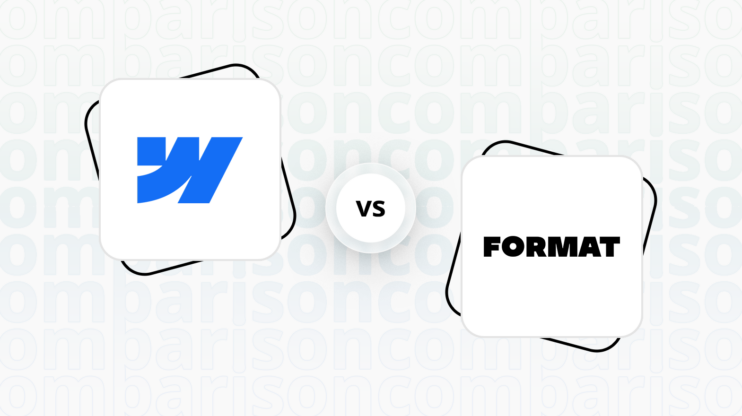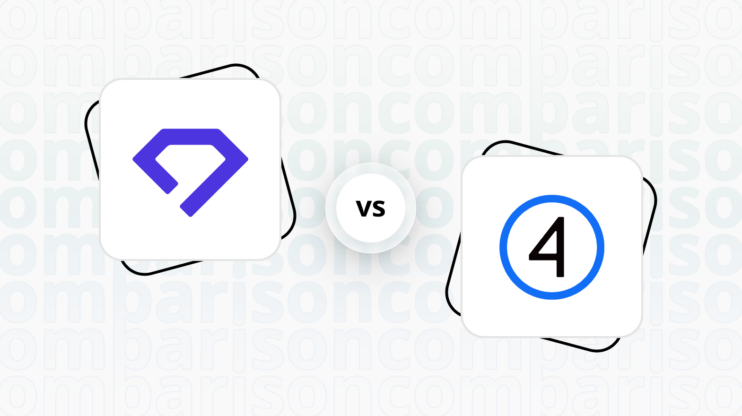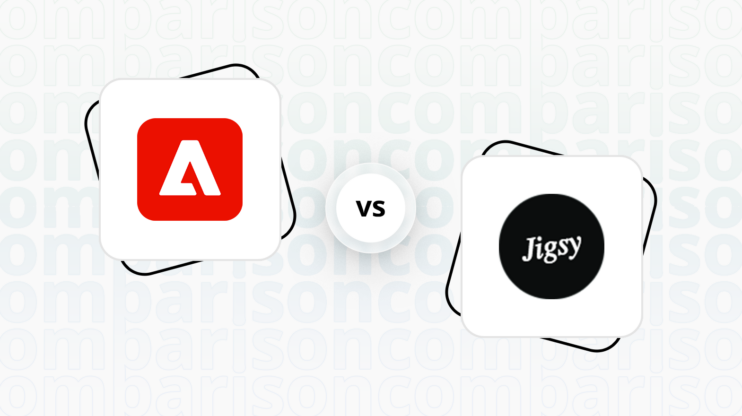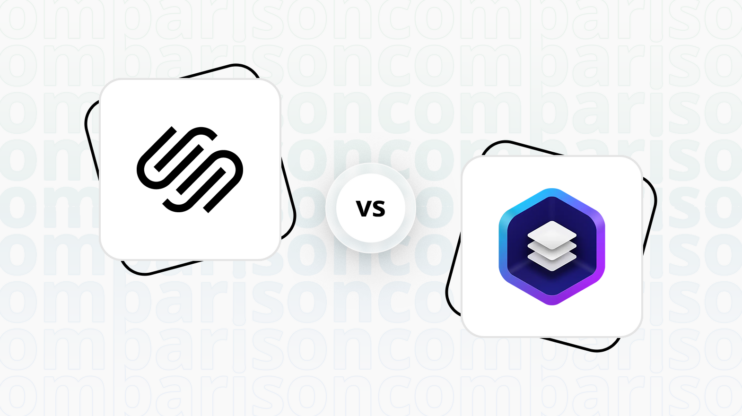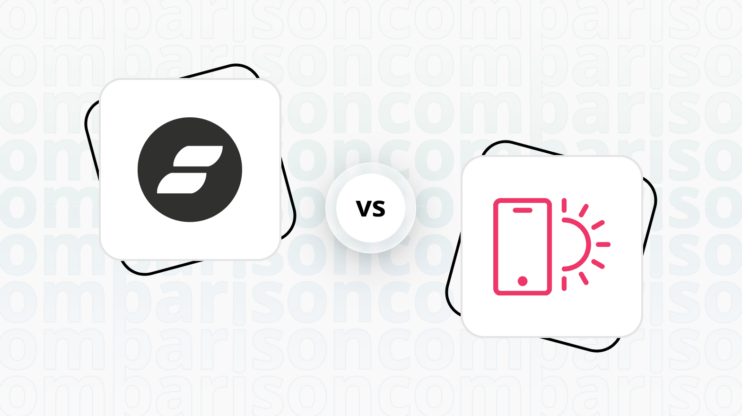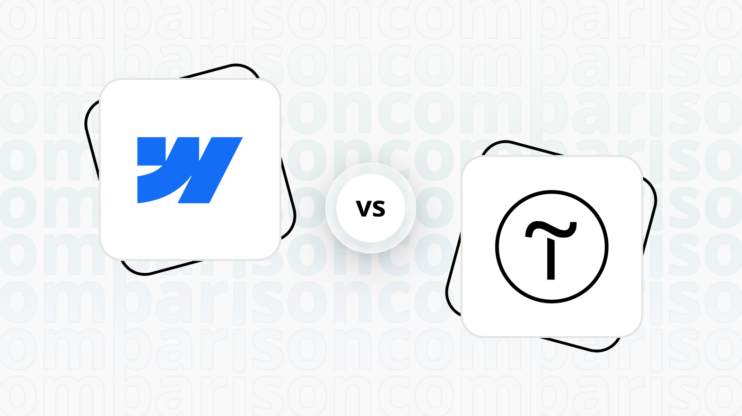Final verdict
Unbounce and SubHub both offer specialized platforms, but they cater to different needs and audiences.
-
Unbounce (Overall Grade: 6.4/10)
excels in creating high-converting landing pages, popups, and sticky bars. It is particularly favored for its strong focus on optimizing conversion rates, making it ideal for marketers and businesses looking to capture leads and launch campaigns. With a user-friendly drag-and-drop interface, a wide range of templates, and numerous integrations, Unbounce is a powerful tool for those aiming to enhance their marketing efforts. -
SubHub (Overall Grade: 5.6/10)
is designed specifically for creating and managing membership sites. It offers a range of tools tailored for content creators and entrepreneurs who aim to build a community and monetize their content. SubHub simplifies the process of setting up subscription models and managing member access, making it an ideal choice for those looking to start or grow their membership-based business. While it may lack some advanced features, its focus on ease of use and efficiency makes it a strong contender in its niche.

|

|
|
|---|---|---|
|
Design functionalities & templates |
7.8 |
6.8 |
|
Ease of use |
8.2 |
7.7 |
|
Ecommerce |
4.8 |
5.9 |
|
Website Editors |
7.5 |
6.9 |
|
Product testing options |
6.6 |
7.0 |
|
Price |
7.0 |
6.8 |
|
Hosting quality |
3.9 |
5.5 |
|
Website speed optimization |
5.6 |
5.6 |
|
Plugins/extensions and integrations |
6.8 |
5.7 |
|
Marketing features |
7.4 |
5.7 |
|
Customer support |
7.7 |
6.3 |
|
Website security |
8.4 |
4.0 |
|
AI capabilities |
7.5 |
0 |
|
User Management |
7.2 |
5.2 |
Best for ecommerce
 4.8
4.8
 5.9
5.9
Verdict
: Unbounce and SubHub cater to different ecommerce needs. Unbounce excels in conversion optimization for landing pages, while SubHub is better suited for membership-based ecommerce.
-
Unbounce
: Unbounce is designed for creating high-converting landing pages with ecommerce integrations like Shopify and Ecwid. It focuses on conversion optimization with features like A/B testing and Smart Traffic insights. However, it lacks comprehensive ecommerce templates and advanced product management features, making it less ideal for full-fledged online stores. -
SubHub
: SubHub is tailored for membership sites, offering tools for selling physical and digital products and pay-per-view content. It provides customizable storefronts, flexible shipping options, and inventory management. While it lacks some advanced ecommerce features, it is a solid choice for content creators and entrepreneurs looking to monetize their membership sites.
Best for informational & business websites
 5.9
5.9
 7.2
7.2
Verdict
: When it comes to Unbounce vs SubHub for informational business websites, SubHub takes the lead with a score of 7.2 compared to Unbounce’s 5.9. SubHub’s focus on membership sites and ease of use makes it a better choice for content creators and entrepreneurs looking to build a community and monetize their content.
-
Unbounce
: Unbounce is a powerful tool for creating custom landing pages, popups, and sticky bars, with a strong focus on optimizing conversion rates. It offers a wide range of templates and a drag-and-drop interface, making it easy to create and test different layouts. However, its primary strength lies in conversion optimization rather than serving as a comprehensive platform for informational business websites. -
SubHub
: SubHub excels in creating and managing membership sites, offering tools tailored for content creators and entrepreneurs. It simplifies the process of setting up subscription models and managing member access, making it an ideal choice for those looking to start or grow a membership-based business. Its user-friendly platform and focus on ease of use make it a superior option for informational business websites compared to Unbounce.
Detailed comparison
Design functionalities & templates
Design FunctionalitiesRepresents how well each platform allows for creative design and customization of websites.Score Components:
- Template Variety (30%): Range and quality of design templates.
- Customization (30%): Flexibility and options for design alterations.
- User Interface (20%): Ease and intuitiveness of the design process.
- Responsiveness (10%): Adaptability to different devices and screen sizes.
- Innovation (10%): Unique design features and tools.
 7.8
7.8
 6.8
6.8
🏆
Winner: Unbounce.
Unbounce offers a more comprehensive and flexible design experience, with a higher score in design functionalities and templates.
Unbounce provides a gallery of over 100 high-converting templates for landing pages, popups, and sticky bars. These templates are designed with conversion in mind, incorporating knowledge and insights gained from Unbounce’s experience in optimizing landing pages. Users have the flexibility to choose from these ready-to-use templates or start with a blank canvas to create their own designs using Unbounce’s drag-and-drop builder.
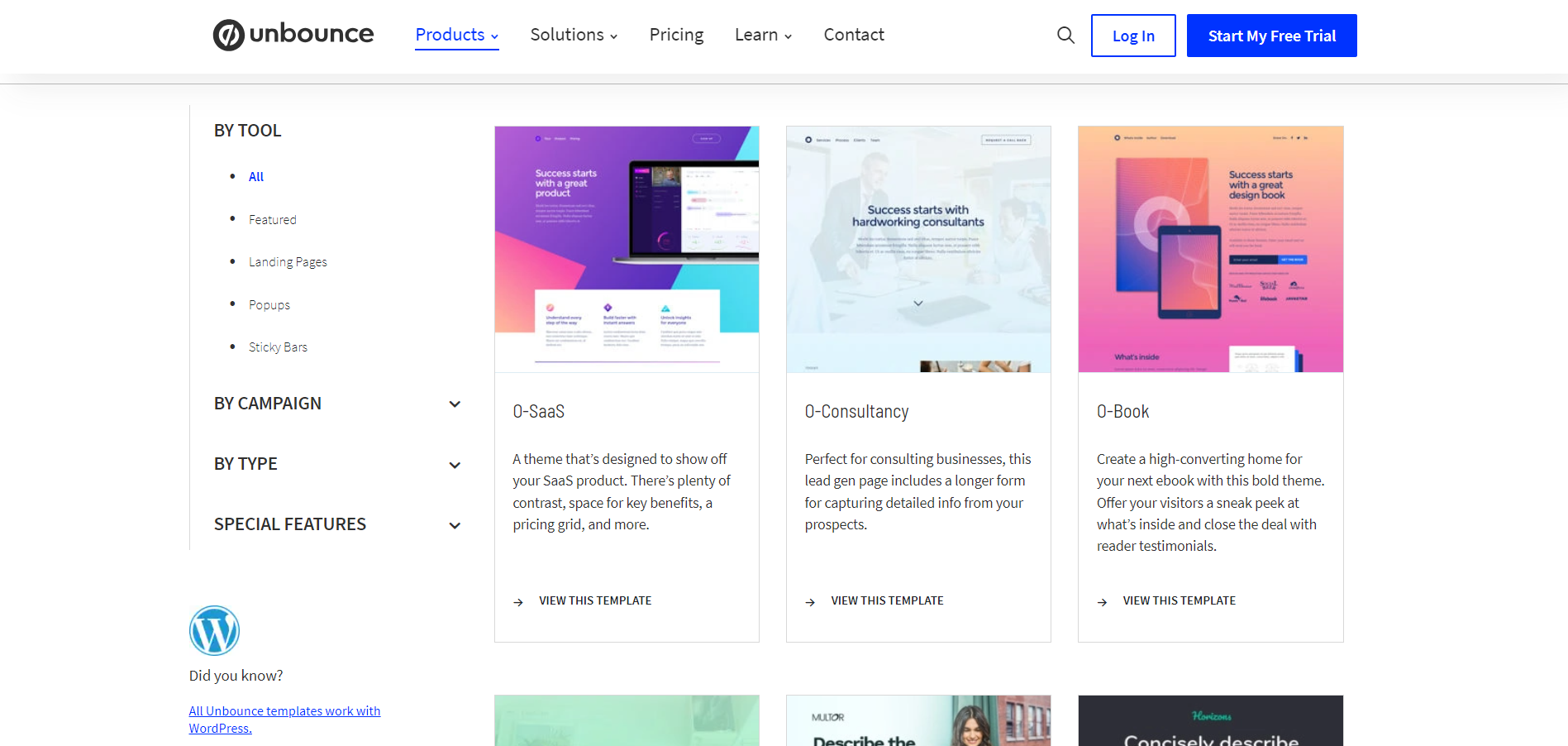

On the other hand, SubHub offers a variety of customizable membership website templates designed to cater to different needs and themes. There are 14 specifically themed templates available, each designed to help users jump-start the design of their membership website homepages. These templates are fully customizable, allowing users to modify layouts, add or remove sections, and tailor content to fit their brand, ensuring flexibility in the design process.
Get a head start on website creation with AI
Create a custom website tailored to your business needs 10X faster with 10Web AI Website Builder!
Ease of use
Ease of useReflects the platform’s overall user-friendliness.Score
Components:
- Learning curve (40%): Quickness and ease of getting started.
- Interface design (30%): Simplicity and intuitiveness of layout.
- User guidance (20%): Quality of tutorials and support.
- Flexibility (10%): Adaptability to various user skills.
 8.2
8.2
 7.7
7.7
🏆 Winner: Unbounce
. Scoring 8.2, Unbounce is known for its intuitive drag-and-drop builder and a wide selection of templates, making it easy for users to design and customize landing pages. SubHub, with a score of 7.7, offers a user-friendly platform designed for building membership websites and online courses, but may lack some advanced features found on other platforms. If ease of use is a priority, Unbounce is the clear winner in this category.
Learning Resources
🏆 Winner: Unbounce
. Unbounce offers a rich collection of learning resources designed to help users maximize their platform’s capabilities, including a comprehensive Help Centre, the Unprompted Podcast for marketing insights, and a Video Library for visual learning. SubHub also offers a range of learning resources, including video guides and tutorials, but lacks a large community of users across various platforms.
For ecommerce
EcommerceMeasures the platform’s effectiveness in supporting online business activities.Score Components:
- Ecommerce themes and templates (20%): Variety and design of templates.
- Product management (25%): Ease of managing and organizing products.
- Payment options (25%): Variety and convenience of payment methods.
- Ecommerce features (20%): Features for managing an ecommerce store.
- Integration (10%): Compatibility with external e-commerce tools and services.
 4.8
4.8
 5.9
5.9
Unbounce and SubHub both offer ecommerce capabilities, but their offerings are tailored to their specific use cases. Unbounce, a landing page builder, focuses on conversion optimization, while SubHub, a membership site builder, provides tools for selling physical and digital products and pay-per-view content.

|

|
|
|---|---|---|
|
Ecommerce themes and templates |
2.0 |
3.0 |
|
Product page customization |
3.0 |
6.5 |
|
Payment processing and commissions |
6.5 |
7.0 |
|
POS capabilities |
0.0 |
0.0 |
|
Payment gateways |
7.0 |
6.0 |
|
Product numbers |
0.0 |
5.0 |
|
Additional ecommerce features |
4.5 |
4.5 |
Unbounce ecommerce features:
- Unbounce integrates with ecommerce platforms like Shopify and Ecwid, allowing users to create, test, and customize highly targeted ecommerce landing pages.
- Its features are centered around conversion optimization, including A/B testing and Smart Traffic insights, alongside the unique Smart Copy features for enhanced copywriting.
- However, it’s worth noting that Unbounce’s entry-level plans lack key features like A/B testing, and users have reported challenges with customer support and limited template selections.
SubHub ecommerce features:
- SubHub supports the sale of physical and digital products, as well as pay-per-view content.
- It offers a customizable storefront and product categories, flexible shipping and tax configurations, inventory management, and automatic order confirmation emails.
- However, it lacks support for distributing free products and does not manage the dispatch of physical goods, which means sellers may need to handle their own shipping logistics.
Ecommerce themes & templates
Unbounce primarily focuses on building landing pages, and does not have ecommerce specific templates. Similarly, SubHub does not offer ecommerce specific templates.
Product page customization
Unbounce allows for the creation and customization of product pages, primarily focusing on building landing pages, with the possibility to integrate with ecommerce platforms such as Shopify or Ecwid. On the other hand, SubHub offers a range of product page customization options, including the ability to manage product variants, upload images, and set visibility preferences. Users can also implement SEO strategies through meta tags and manage tax settings. Additional functionalities include member-specific discounts, image carousels, and individualized shipping costs.
Payment processing
Unbounce supports payment processing through an integration with Stripe, allowing users to create landing pages that can handle transactions directly. Unbounce itself does not mention charging additional fees for transactions, implying that fees are subject to Stripe’s own pricing structure. The platform is focused on optimizing online conversions and does not offer Point of Sale (POS) capabilities.
SubHub supports two main payment gateways: Stripe and PayPal. These integrations allow for secure payment processing for subscriptions and store items using debit or credit cards. The platform itself does not charge commissions on transactions.
Website Editors
Website EditorsEvaluates the platforms’ website building and editing capabilities.Score Components:
- Customization tools (40%): Range and power of editing features.
- Editor usability (30%): User experience within the editor.
- Design flexibility (20%): Freedom in layout and design changes.
- Update and maintenance ease (10%): Simplicity of updating and maintaining the site.
 7.5
7.5
 6.9
6.9
🏆
Winner: Unbounce
. Unbounce, with a score of 7.5, is a powerful, user-friendly website builder specifically designed for creating custom landing pages, popups, and sticky bars. It provides a wide range of templates and a drag-and-drop interface, making it easy to create and test different layouts and elements to see what works best for your audience. Additionally, it integrates with numerous marketing tools and analytics platforms, enabling marketers to capture leads, launch campaigns, and analyze performance data all in one place.
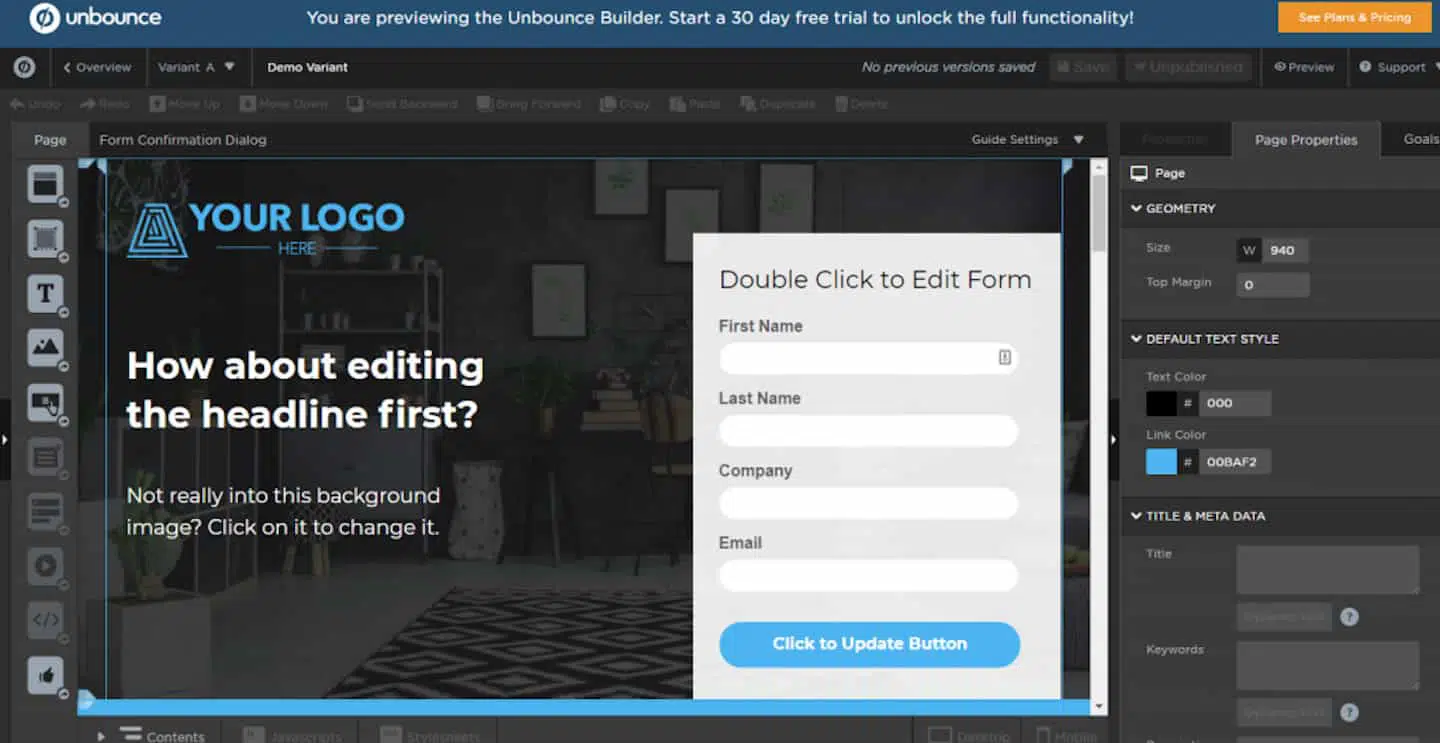
SubHub, scoring 6.9, is a website builder designed specifically for creating and managing membership sites. It offers a range of tools tailored for content creators and entrepreneurs who aim to build a community and monetize their content. The platform simplifies the process of setting up subscription models, managing member access, and providing exclusive content, making it an ideal choice for those looking to start or grow their membership-based business.
Mobile editor/app
 0
0
 4.0
4.0
🏆
Winner: SubHub
. Neither Unbounce nor SubHub offer a dedicated mobile editor app. However, SubHub allows users to manage some content on their website using the mobile browser version. It’s important to note that it’s not possible to change the layout and design of the website on mobile with SubHub. On the other hand, Unbounce does not provide any mobile editing capabilities.
Therefore, despite its limitations, SubHub is the winner in this comparison due to its ability to perform some content management tasks on mobile.
Product testing options
Product Testing OptionsAssesses the options for trying out platform features before commitment.Score Components:
- Trial quality (40%): Extent and usefulness of the trial or free version.
- Feature accessibility (30%): How many features are available to test.
- Trial duration (20%): Length of the trial period.
- Ease of transition (10%): Smoothness of moving from trial to paid plans.
 6.6
6.6
 7.0
7.0
Overall Result
:
SubHub Wins
. SubHub scores slightly higher than Unbounce with a score of 7.0 compared to Unbounce’s 6.6. Both Unbounce and SubHub offer a 14-day free trial, but SubHub edges out with a 7-day money-back guarantee. Unbounce allows testing of premium features during the trial, but requires billing information for free trial users. SubHub allows testing of premium features during the trial without any such requirement.

|

|
|
|---|---|---|
|
Free Plan |
No | No |
|
Trial Duration |
14 days | 14 days |
|
Testing Premium Features |
Yes, with billing information |
Yes, during the free trial |
|
Money Back Guarantee |
No |
Yes, 7 days |
Price
PriceLooks at the cost-effectiveness and value for money of each platform.Score Components:
- Plan value (40%): What each pricing tier offers.
- Transparency and clarity (30%): Clearness of pricing structures.
- Flexibility of plans (20%): Range of options to suit different budgets.
- Hidden costs (10%): Additional expenses not included in the plan.
 7.0
7.0
 6.8
6.8
Unbounce and SubHub have similar pricing scores, but Unbounce offers more advanced features for optimizing conversion rates, while SubHub is more focused on content creators and entrepreneurs looking to monetize their content.

|

|
|
|---|---|---|
|
$40-$50 |
No offering at this amount. |
Starter ($47/month): Up to 500 members, 5 GB storage, secure payment processing, course builder, 5 landing pages, e-commerce. Value for price: 6.5 |
|
$90-$100 |
Build ($99.00/month): Provides tools for building and launching high-converting landing pages, unlimited pages, popups, sticky bars, a form builder, free hosting, AI copywriting, custom scripts, 1,000+ integrations, support for 1 root domain with unlimited subdomains, catering up to 20,000 monthly unique visitors. Value for price: 6.5 |
Pro ($97/month): Up to 2000 members, 50 GB storage, removes SubHub branding, 15 landing pages, along with Starter features. Value for price: 7.5 |
|
$100-$200 |
Experiment ($149.00/month): Includes everything in the Build plan plus unlimited A/B tests, advanced reporting, dynamic text replacement, support for 2 root domains, and up to 30,000 monthly unique visitors. Value for price: 7.5 |
Premium ($147/month): Unlimited members, 200 GB storage, email white labelling, 30 landing pages, plus all Pro features. Value for Price: 8.5 |
|
$200-$300 |
Optimize ($249.00/month): Adds to the Experiment plan with AI traffic optimization, visitor behavior insights, advanced targeting, supports 3 root domains, and caters to up to 50,000 monthly unique visitors. Value for price: 8.0 |
No offering at this amount. |
|
$600+ |
Concierge (Starting at $649/month): Offers everything in the Optimize plan plus dedicated support, implementation services, client and user management, flexible add-on plans for scaling, starting with 5 root domains and 100,000 monthly unique visitors, with options to scale. |
No offering at this amount. |
location. As a result in rare cases the prices displayed here can differ from the ones you see on their
websites.
Hosting quality
Hosting
qualityExamines the reliability and performance of the hosting solutions.Score Components:
- Uptime (40%): Consistency and reliability of website availability.
- Speed (30%): Loading times and performance.
- Bandwidth and storage (20%): Sufficiency of resources provided.
- Data centers (10%): Quality and distribution of hosting infrastructure.
 3.9
3.9
 5.5
5.5
🏆
Winner: SubHub
. While both Unbounce and SubHub offer hosting services, SubHub provides more transparency about its hosting type, offering managed cloud hosting with storage limitations depending on the plan. Unbounce, on the other hand, does not specify the type of hosting it provides. Neither platform provides information about their data centers or an uptime guarantee, but Unbounce does report a 99.96% uptime.

|

|
|
|---|---|---|
|
Do they offer hosting? |
Yes |
Yes |
|
Data Centers: |
Not disclosed |
Not disclosed |
|
Type of hosting: |
Not specified |
Managed Cloud Hosting |
|
Uptime: |
99.96% |
Not provided |
|
Uptime Guarantee: |
No |
Not provided |
Website Speed Optimization
Website Speed OptimizationEvaluates optimization of website loading timesScore Components:
- PageSpeed Score (30%): Google’s score indicating performance optimization.
- Loading Time (30%): The average time until a website is fully interactive.
- Mobile Optimization (15%): Optimization effectiveness for mobile devices.
- Resource Optimization (15%): Optimizing images, scripts, and other heavy resources.
- CDN Usage (10%): Use of CDN to enhance speed across geolocations.
 5.6
5.6
 5.6
5.6
🏆 Winner: Tie
Both Unbounce and SubHub have the same score for website speed optimization, and they both use similar strategies for speed optimization. However, neither of them provide any information on their Core Web Vital improvements. The load times and PageSpeed scores for both builders vary depending on optimization and website complexity.

|

|
|
|---|---|---|
|
Focus |
Conversion rate optimization |
Membership site optimization |
|
Performance Tools |
Speed Booster |
Mobile Optimized design |
|
Key Strategies |
Image optimization, Caching, Speed Booster |
Image Optimization, Caching, Mobile Optimized design |
|
Load Times |
Varies depending on optimization and website complexity |
Varies depending on optimization and website complexity |
|
Page Speed Scores Range |
Varies depending on optimization and website complexity |
Varies depending on optimization and website complexity |
|
Core Web Vitals Improvement |
No information provided |
No information provided |
Unbounce is a powerful, user-friendly website builder specifically designed for creating custom landing pages, popups, and sticky bars. It is particularly favored for its strong focus on optimizing conversion rates, allowing users to design high-converting pages without needing any coding skills. Unbounce provides a wide range of templates and a drag-and-drop interface, making it easy to create and test different layouts and elements to see what works best for your audience. Additionally, it integrates with numerous marketing tools and analytics platforms, enabling marketers to capture leads, launch campaigns, and analyze performance data all in one place.
Subhub is a website builder designed specifically for creating and managing membership sites. It offers a range of tools tailored for content creators and entrepreneurs who aim to build a community and monetize their content. The platform simplifies the process of setting up subscription models, managing member access, and providing exclusive content, making it an ideal choice for those looking to start or grow their membership-based business. With Subhub, users can create a professional and secure website without needing advanced technical skills, emphasizing ease of use and efficiency.
Get a head start on website creation with AI
Create a custom website tailored to your business needs 10X faster with 10Web AI Website Builder!
Plugins and integrations
Plugins and integrationsMeasures the range and effectiveness of additional plugins and integrations.Score Components:
- Variety of options (40%): Range of available add-ons.
- Integration smoothness (30%): Ease of integrating plugins into the site.
- Quality of plugins (20%): Functionality and reliability of the options.
- Custom integration capabilities (10%): Support for custom or third-party integrations.
 6.8
6.8
 5.7
5.7
🏆 Winner: Unbounce.
Unbounce scores 6.8, offering a wide array of apps and integrations to enhance the functionality of landing pages. It integrates with numerous marketing tools and analytics platforms, enabling marketers to capture leads, launch campaigns, and analyze performance data all in one place. SubHub, with a score of 5.7, offers a set of built-in features and limited third-party integrations primarily with MailChimp, Google Analytics, and payment gateways like Stripe and PayPal. While Subhub provides a comprehensive toolkit for creating and managing membership sites, its range of external integrations might be seen as limited compared to Unbounce.

Marketing Features
Design FunctionalitiesRepresents how well each platform allows for creative design and customization of websites.Score Components:
- Template Variety (30%): Range and quality of design templates.
- Customization (30%): Flexibility and options for design alterations.
- User Interface (20%): Ease and intuitiveness of the design process.
- Responsiveness (10%): Adaptability to different devices and screen sizes.
- Innovation (10%): Unique design features and tools.
 7.4
7.4
 5.7
5.7
🏆
Overall Winner: Unbounce
. Unbounce stands out for its strong focus on optimizing conversion rates and its ability to integrate with numerous marketing tools and analytics platforms. SubHub, on the other hand, is designed specifically for creating and managing membership sites, offering a range of tools tailored for content creators and entrepreneurs.

|

|
|
|---|---|---|
|
SEO Tools |
|
|
|
Email Marketing |
Yes, with integration of third-party services |
Yes, both built in and through integration of Mailchimp |
|
Blogging |
No |
|
|
Social Media Integration |
|
No |
|
Analytics and Reporting |
|
|
|
Ads and Promotions |
Yes, Unbounce landing pages can be used for ad campaigns |
|
Customer Support
Customer supportEvaluates the quality and availability of support options.Score Components:
- Response time (40%): Speed of support responses.
- Support quality (30%): Effectiveness and helpfulness of the support.
- Availability (20%): Range of support channels (phone, chat, email).
- Resource richness (10%): Quality of self-help and educational materials.
 7.7
7.7
 6.3
6.3
🏆 Winner: Unbounce
. In the comparison of Unbounce vs SubHub, Unbounce takes the lead with a customer support score of 7.7. Unbounce offers a variety of support options, including live chat, email, and phone support available Monday to Friday, from 6 AM to 6 PM PST. Additionally, users have access to 24/7 support through their Help Centre, Community, and Chat Bot, ensuring continuous assistance.
SubHub, on the other hand, provides customer support primarily through email and a support portal for detailed queries. While it also offers an FAQ section for immediate answers, its support system is not as comprehensive as Unbounce’s. With a customer support score of 6.3, SubHub’s support is accessible but may not be as responsive or extensive as Unbounce’s offerings.
Security
SecurityLooks at the platforms’ security measures and data protection.Score Components:
- Data protection (40%): Safeguards for user and customer data.
- SSL and encryption (30%): Implementation of secure connections.
- Compliance (20%): Adherence to industry security standards.
- Regular updates (10%): Frequency of security updates and patches.
 8.4
8.4
 4.0
4.0
🏆
Winner: Unbounce
. Unbounce has a higher security score and provides a more comprehensive security framework. It ensures compliance with key regulations, employs a defense-oriented architecture, and uses network safety measures. Unbounce’s systems reside within a private virtual network on AWS, minimizing attack risks and ensuring swift recovery processes. Encrypted communications and stringent firewall policies further enhance protection against external threats.
SubHub, on the other hand, does not disclose any specific information about the website security measures it provides. While it does emphasize compliance with GDPR and CCPA regulations in its privacy policy, the lack of detailed information about its security measures puts it at a disadvantage compared to Unbounce.
AI Capabilities
AI capabilitiesMeasures the effectiveness of AI-driven features and tools.Score Components:
- Automation efficiency (40%): Impact of AI on streamlining processes.
- Personalization (30%): AI-driven customization for users or customers.
- AI-Assisted design (20%): Role of AI in website design and functionality.
- Data analysis (10%): Use of AI in interpreting user data and analytics.
 7.5
7.5
 0
0

|

|
|
|---|---|---|
|
Personalized Design |
Unbounce’s Smart Builder offers personalized templates and design recommendations |
|
|
Content Generation |
Unbounce’s Smart Copy generates various types of content for marketing and landing pages |
|
|
Visitor Traffic Management |
Unbounce’s Smart Traffic directs visitors to the most appropriate landing page variant |
|
|
Conversion Optimization |
Unbounce’s Conversion Intelligence Insights offers practical advice and recommendations to boost conversion rates |
|
🏆 Winner: Unbounce
. Unbounce, with a score of 7.5, utilizes AI to enhance the user experience in creating and managing landing pages. Its AI features focus on personalized design, content generation, visitor traffic management, and conversion optimization.
SubHub, on the other hand, does not have any AI capabilities.
User Management
User ManagementAssesses the platforms’ capabilities in managing user roles, permissions, and accessibility.Score Components:
- Role Customization (40%): Flexibility in creating and defining user roles and
permissions. - Ease of Management (30%): User interface and tools for managing users.
- Access Control (20%): Effectiveness of access control measures for different user
levels. - Scalability (10%): Ability to manage a growing number of users efficiently.
 7.2
7.2
 5.2
5.2
🏆 Winner: Unbounce
. Unbounce and SubHub offer different approaches to user management.
- Unbounce offers one staff account on its basic plan, with the option to expand up to 15 accounts on the premium plan. It also provides customizable permissions, enabling you to restrict or grant access based on roles such as viewer, author, and administrator.
- SubHub allows multiple user accounts, however the platform does not specify how many accounts are supported.
Unbounce User Roles and Access Levels:
| Role | Description | Access Highlights |
|---|---|---|
| Viewers | Members of your team who want to view and approve pages, popups, or sticky bars before publication. | Can access pages, popups, sticky bars, stats, and leads. Cannot edit/manage pages or access account management, billing details, domains, or add users. |
| Authors | Designers or copywriters invited to edit landing pages. | Can edit, manage, publish/unpublish pages, popups, sticky bars. Have access to viewing leads and stats. Cannot access account management, billing details, domains, or add users. |
| Administrators | Manage the Unbounce account, including billing details. | Can edit, manage, publish/unpublish pages, popups, sticky bars. Can access account management, billing details, domains, and add users. Cannot delete leads or remove other Admins. |
SubHub User Roles and Access Levels:
| Role | Description | Access Highlights |
|---|---|---|
| Administrator | Full access to the platform except for Homepage and Course Editor. | Can manage all aspects of the platform, including content, store, and member management. |
| Content Management | Focuses on managing and organizing content within the platform. | Can access and manage content-related features but does not have access to Homepage or Course Editor. |
| Store (access only) | Specializes in handling the platform’s store features. | Limited to store management functions; no access to Homepage, Course Editor, or member management. |
| Member Manager (access only) | Oversees member accounts, roles, and subscriptions. | Can manage members and their subscriptions but cannot access Homepage, Course Editor, or store management. |
| *Origin Admin Email | The initial administrator with the highest level of access, including Homepage and Course Editor. | Exclusive access to Homepage and Course Editor, on top of what the Administrator role provides. |
Additional Features

|

|
|
|---|---|---|
|
SSL Certificate |
|
|
|
Custom Domain |
|
|
|
Free Custom Domain Included |
|
|
|
International Domains |
|
|
|
Mobile Responsive |
|
|
|
Page Speed |
|
|
|
Website Builder Mobile App |
|
|
|
Convert a Website To An App |
|
|
|
Website Analytics |
|
|
|
Multilingual Sites |
|
|
|
Multiple Users |
|
|
User Feedback
The reviews for Unbounce reveal a mixed sentiment among users. On the positive side, many appreciate its user-friendly, drag-and-drop page builder, which facilitates the quick creation and editing of landing pages without the need for technical expertise. Users find it beneficial for A/B testing, integrating with CRMs, and swiftly turning around marketing content. However, there are notable concerns, particularly with a case of unexpected switch to an annual plan without consent and refusal to refund, indicating potential issues with customer service and billing practices. Additionally, some users mention technical limitations, such as responsiveness issues and the absence of global elements for content updates across multiple pages, which can hinder efficiency.
User feedback on SubHub presents a mix of positive and negative experiences, emphasizing the platform’s feature-rich environment and customizable templates. Users appreciate the flexibility and the quality of customer service, highlighting the platform’s continual updates and support as key benefits. However, some users express dissatisfaction with aspects such as the platform’s interface, lack of community features, and service fees for ticket resale. Concerns were also raised about the custom design service and mobile-friendly solutions taking longer than expected.
The making of this blog
We followed a clear, step-by-step process to write and research this article.
FAQ
What are the main differences between Unbounce and SubHub?
Can I use Unbounce for ecommerce?
Is SubHub good for building a membership site?
Which platform is easier to use, Unbounce or SubHub?
How do Unbounce and SubHub compare in terms of pricing?
Which platform offers better customer support, Unbounce or SubHub?
Can I create a multilingual site with either Unbounce or SubHub?










